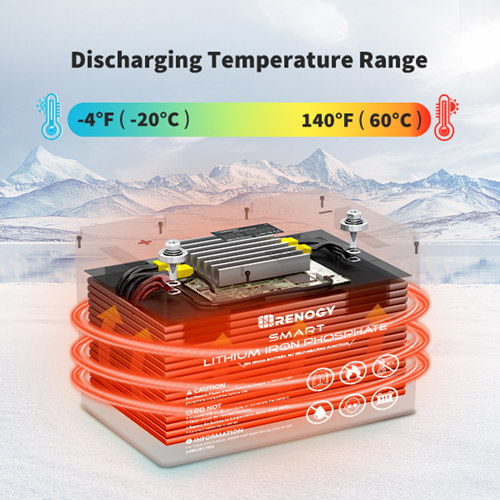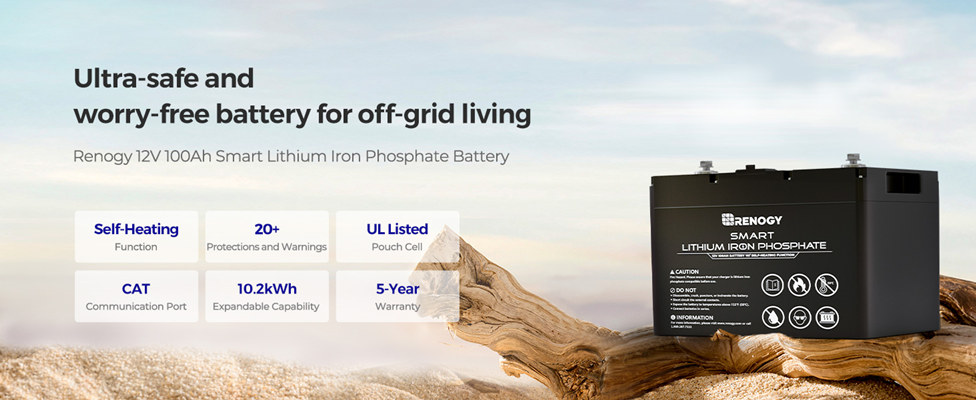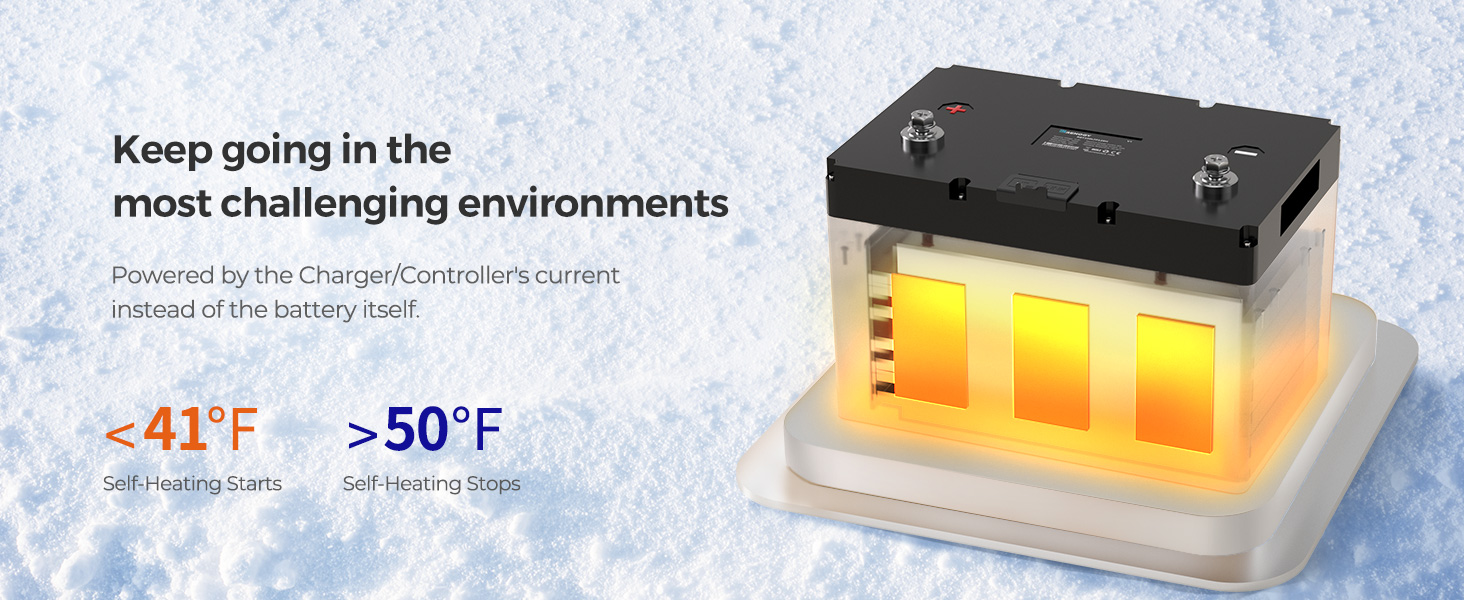Battery Dies in Cold Weather: What Low Temperatures Do to Your Battery
Intriguing yet frustrating, why do batteries die in cold weather? Temperature is one of the most influential factors in a battery's performance.
When the temperature drops, the chemical reactions required to generate energy become slower and less efficient, causing a decrease in the capacity and discharge rate of the battery. Additionally, the battery becomes less mechanically stable and charging can cause further damage.
In this blog post, learn why cold weather is so detrimental to battery life and the five ways to keep batteries warm in the cold.
Table of contents
- Battery Dies in Cold Weather: Why?
- How Does Cold Weather Affect Lithium-Ion Batteries?
- Understanding the Chemical Reactions in Cold Temperatures
- Can Lithium Batteries Freeze?
- What Temperature Is Bad for Lithium Batteries?
- How to Keep Lithium Batteries Warm in Cold Weather (5 Great Ways)
- Use Lithium-Ion Batteries That Last Longer in Extreme Cold
Battery Dies in Cold Weather: Why?
Battery cells are sensitive to environmental conditions and are usually tested to survive a wide range of temperatures. But when the temperature drops significantly, it can cause serious damage to your batteries. But why do batteries die in the cold?

When the temperature drops, the chemical reactions required to generate energy become slower and less efficient. This prolonged stress causes a degradation in capacity and discharge rate of the battery. Additionally, the battery becomes less mechanically stable, raising the possibility of a sudden failure.
Furthermore, if the charging process of a battery is carried out in cold weather, the chemical reactions can be compromised even further. Battery cells such as lithium-ion batteries operate on reversible reduction reactions, and when temperature drops significantly, rapid plating occurs ( deposition of lithium ion on the anode without intercalation into the carbon sites). With this, the separator within the cell can be punctured and cause a short that kills the battery.
How Does Cold Weather Affect Lithium-Ion Batteries?
Have you ever had to abandon an outdoor project or a road trip because your lithium-ion batteries had died prematurely due to the cold weather? Well, cold weather is hard on lithium-ion batteries and can significantly reduce their efficiency and performance, regardless of their reputation as one of the best batteries in cold weather.
Lithium batteries discharge an electric current when the transfer of lithium-ion occurs from the graphite anode (negative electrode) to the cathode (positive electrode). This process slows down in cold weather thus weakening their power. As the temperature drops, the lithium ions will just coat the anode (lithium plating) thus increasing the resistance of the electrolyte and making fewer lithium ions available to cause the flow of electricity. This can reduce 20-30% of the rated battery capacity, although ideally, lithium-ion batteries should operate at 98-95% of the rated capacity.
In short, we can say that while lithium batteries still maintain most of their performance in cold weather and are probably still the best batteries in cold weather, they can experience significant shortcomings if not used, charged and stored according to specifications for cold weather. Therefore, it is important to consider these negative effects of lithium batteries in cold weather when planning any project, road trips and so on in cold weather.
Understanding the Chemical Reactions in Cold Temperatures
As mentioned above, when temperatures drop, the intercalation rate of lithium ions at the graphite electrode and the conductivity of the electrolyte within the battery decrease.
The intercalation reaction is divided into two steps: ion insertion and ion adsorption. The ion insertion process is the movement of lithium ions from the cathode surface into the graphite carbon sites. The ion adsorption process is the assimilation of lithium ions on the surface of the carbon mesh. The activation energy for intercalation decreases with decreasing temperature, and consequently decreases the rate of lithium insertion and adsorption.
The lithium plating reaction is the process by which lithium ions form an extended trench of alloy at the cathode surface, reducing the number of lithium ions available for insertion in the carbon sites. As the temperature drops, the formation of the alloy increases, which increases the rate of plating. This plating not only reduces the quantity of lithium ions available for intercalation but also slows down the rate of intercalation.

Table source: An experimental study of a lithium ion cell operation at low temperature conditions from SicenceDirect
Given the above information, it is clear that when temperatures drop, a lithium-ion battery's ability to work is compromised.
Can Lithium Batteries Freeze?
It’s a common question: “Do lithium batteries freeze?” The fact is, if you take a literal interpretation of the term “freeze”, the answer would have to be no. However, the battery's ability to power devices under freezing temperatures can be greatly impeded and shortened.
When lithium batteries are exposed to low temperatures, the rate of lithium-ion transfer in and out of the anode is decreased at a rapid rate. This decrease in the rate of lithium-ion transfer is caused by the lithium-ion alloy that plates onto the surface of the anode preventing entry of the ions into the carbon site of the anode. As a result, this prevents current flow and drastically reduces the battery capacity. In other words, the battery “freezes” if the lithium-ion isn’t able to make its way through the anode.
Besides a reduction in capacity, freezing temperatures also affect certain battery components in a more damaging way. For example, the electrolyte could become stiff and be circulated less smoothly, thus decreasing the rate of lithium-ion transfer. A decrease in capacity results in a decrease in the battery voltage and output power.
In short, freezing temperatures do negatively impact lithium batteries, even though you can’t technically “freeze” a battery. When exposed to low temperatures, the lithium-ion won’t be able to transfer as efficiently in and out of the anode and battery components won’t be able to perform as well either.
What Temperature Is Bad for Lithium Batteries?
It is important to understand what temperatures are bad for lithium batteries if you are looking to use them in equipment with wide temperature ranges. Although the optimal temperature range for lithium batteries is -4°F to 140°F, lithium batteries should only be charged in temperatures between 32°F and 131°F (0°C to 55°C) for maximum safety. Higher temperatures can actually lead to an explosion, so it is important to check that the temperature is within the safe range before charging.

So, how cold is too cold for lithium batteries? Unfortunately, any temperature lower than 32°F can cause appreciable damage to the batteries. The chemical reactions when charging lithium batteries below freezing point will slow down to a point where hardly any useful energy is produced. At this point, the batteries may eventually stop working altogether.
If you are looking to use lithium batteries in temperatures below freezing, charging should be avoided since it can cause permanent damage.
How to Keep Lithium Batteries Warm in Cold Weather (5 Great Ways)
Winter is a time that requires extra care and effort when it comes to keeping a lithium battery warm in cold weather. It’s essential to take certain measures in order to make sure that your lithium battery is kept warm while you’re out and enjoying the winter months. Here are 5 great tips to keep your lithium batteries warm in cold weather.
1. Use a battery blanket. Battery blankets are insulated blankets that are used to keep batteries warm in cold weather. They are designed to fit snugly over the battery to keep it from being exposed to the cold temperatures. They provide good insulation to reduce the exposure of the battery cells to the cold environment by trapping heat generated by the battery, while also protecting the battery from the elements.
2. Keep your battery in an insulated storage unit or battery box. Insulated storage units and battery boxes are compact and reusable units made from a variety of materials designed to keep lithium batteries warm by limiting the amount of freezing air that comes into contact with the battery components. The insulation in them also helps to retain any heat generated by the battery and provides additional warmth.
3. Use solar panels to charge them up before heading out in the cold. In cold weather, lithium batteries lose their charge more quickly than usual. It is a great idea to charge lithium batteries using solar panels before you leave your house. Solar panels are a great way of generating a steady and consistent flow of energy that can keep your batteries charged up and at optimum temperature even on the coldest of days.
4. Keep lithium batteries in a heated area such as a garage. Keeping your battery in a heated area such as a garage can make a huge difference in keeping it functioning and warm even in cold weather. By doing this, you will be able to reduce the rate of damage to the battery caused by cold temperatures.
5.Use a battery heater. Battery heaters are a great option for providing insulation for lithium batteries and keeping it warm even in the coldest conditions. Battery heaters designed specifically for lithium batteries will come with adjustable temperatures and settings which you can use to ensure the longevity of your battery in cold weather.
Or if you feel like to learn more about lithium batteries storage methods, check out this article “ How To Store Lithium Batteries & Care Of Lithium Batteries.”
Use Lithium-Ion Batteries That Last Longer in Extreme Cold
To counter the effects of cold weather, you need to invest in a high-quality battery that is robust and efficient. Do I need a heated lithium battery? Yes, you absolutely do if you need to use your lithium battery during extreme cold temperatures.

At Renogy, we offer the very best in advanced lithium-ion batteries that offer maximum performance in extreme cold weather. Our 12V 100Ah Smart Lithium Iron Phosphate Battery w/ Self-Heating Function is designed to not just survive, but thrive in temperatures as low as -41°F. This advanced battery features an automatic self-heating feature that begins at -41°F and stops at 50°F.

Additionally, the Renogy lithium-ion battery ensures that your device is always safe and functioning through an Auto-balancing system and an efficient Battery Management System. It also offers low-temperature protection that kicks in when the charging environment temperature drops below 32°F.
The Renogy lithium-ion battery also uses the latest in pouch cell technology. Unlike metal shells, pouch cells help with heat and gas dispersal. It’s lighter, offers better cycling performance and holds up better in cold temperatures. And it’s also backed by a 5-year warranty, so you can be assured of its long-term performance.
So why not give it a try? We promise you won't regret having a reliable and efficient lithium iron phosphate battery in cold weather.
Related articles:
Solar Battery Storage System Cost: Things You Need To Know
How Does A Solar Battery Bank Work? | Pros And Cons
How To Charge A Lithium Battery?








